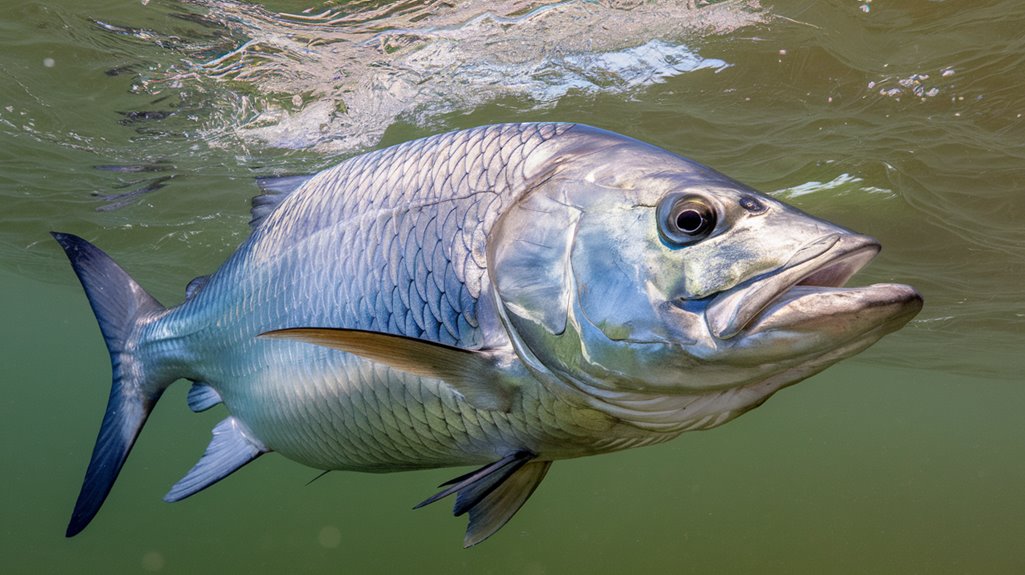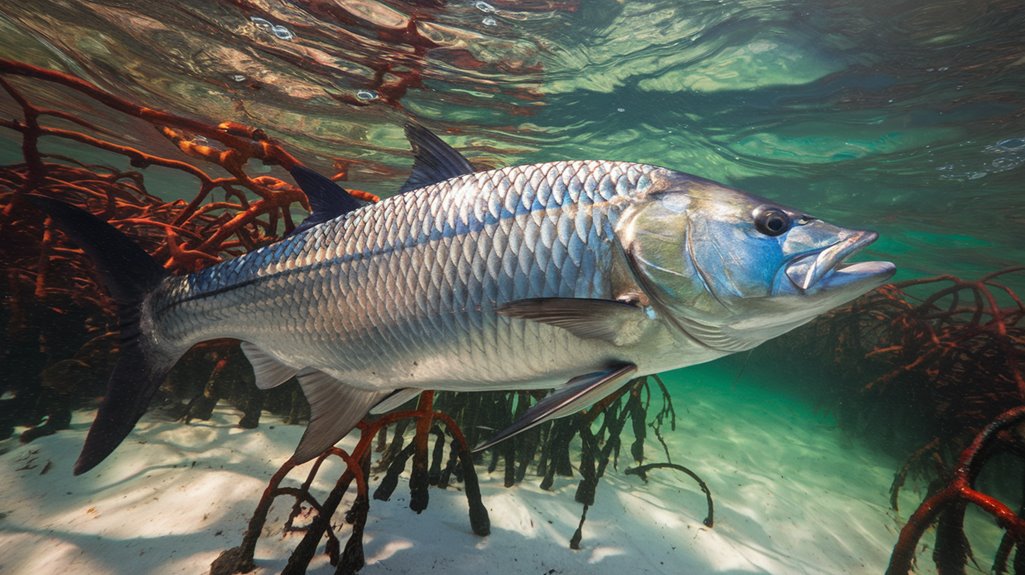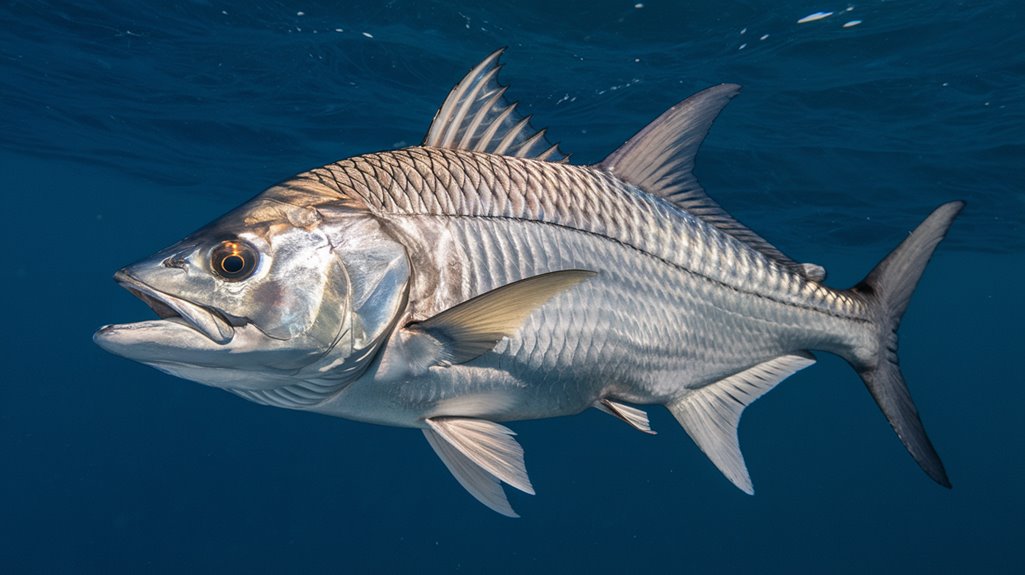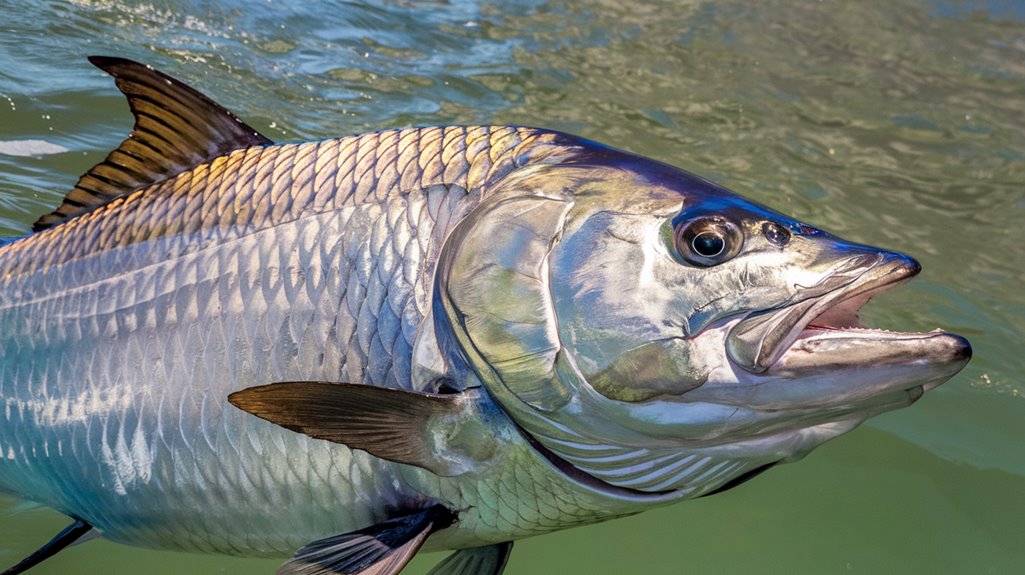You'll find tarpon identification remarkably straightforward once you've mastered their key visual markers. These prehistoric-looking fish display distinctive characteristics, including scales measuring 3-4 inches in diameter and bodies reaching up to 8 feet in length. Their unique dorsal fin configuration and silvery-green coloration set them apart from other coastal species. Understanding these physical traits forms the foundation for accurate field identification and enhanced observation techniques.
Key Takeaways
- Massive silver scales up to 3 inches wide with greenish-blue back and metallic abdomen create distinctive armored appearance.
- Look for surface rolling behavior producing V-shaped wakes, indicating tarpon presence and movement direction.
- Adults reach 8 feet and 300 pounds with elongated jaw structure and specialized bony plates.
- Dorsal fin features 12-16 soft rays with extended terminal ray near tail, unlike similar species.
- Best spotted during calm early mornings in coastal waters, especially Florida Keys and Caribbean regions.
Physical Characteristics and Key Features

A tarpon's distinctive morphology sets it apart from other marine species through several defining characteristics. You'll identify these Atlantic Ocean gamefish by their massive reflective scales, reaching up to three inches in diameter, which create their signature silvery appearance. The physical characteristics include a unique coloration pattern: greenish-blue dorsally, brilliant silver sides, and a metallic abdomen that shifts from turquoise in daylight to black nocturnally. Their elongated jaw structure, featuring specialized bony plates, facilitates prey capture. The dorsal fin's composition of 12-16 soft rays, with an extended terminal ray near the tail, provides a key identifying feature. Adults display impressive dimensions, reaching lengths of 8 feet and weights up to 300 pounds, establishing them as premier gamefish specimens.
Behavioral Patterns and Movement
While tarpon exhibit diverse behavioral patterns, their most distinctive trait involves surface rolling to supplement their oxygen intake through aerial respiration. You'll observe this rolling behavior as an indicator of their movement direction, speed, and feeding activity, particularly during early morning hours when they're most active.
You'll find tarpon either solitary or in schools ranging from small groups to hundreds of individuals. These schools are typically led by a large female lead fish, which determines the group's movement patterns and feeding strategies. During seasonal migrations, you'll notice northward movement in late summer and southward shifts in fall, correlating with water temperature changes. Dawn presents ideal observation conditions, as tarpon demonstrate increased comfort levels and enhanced feeding activity near the surface.
Habitat and Geographic Markers

Tarpon's diverse movement patterns directly connect to their preferred habitats across extensive geographic ranges. You'll find these remarkable fish inhabiting coastal waters from North Carolina's Cape Hatteras southward through the Atlantic to central Brazil, with concentrated populations in the Florida Keys and Caribbean basin.
- Primary habitat zones include shallow waters with sandy mud substrates, where juvenile tarpon establish early development patterns
- Geographic distribution clusters around estuarine systems and brackish waters, particularly in areas with pH variability
- Seasonal migrations influence population density, peaking in Tampa Bay during May-July spawning periods
- Coastal water systems of South Florida serve as critical nursery grounds, especially in areas where mangrove-lined shores meet deeper channels
These habitat preferences demonstrate tarpon's remarkable adaptability to diverse aquatic environments while maintaining consistent geographic markers for species identification.
Seasonal Spotting Techniques
During peak observation periods, you'll maximize tarpon sighting success by implementing specific visual tracking methods that align with their crepuscular behavioral patterns. Focus your search during early morning hours when calm waters provide ideal visibility conditions. Monitor for rolling tarpon behavior as they surface to gather air, creating distinctive V-shaped wakes across the water's surface.
To enhance detection accuracy, position yourself to leverage contrasting colors. You'll spot their reflective sides more effectively against light-colored sandy bottoms, while accounting for reduced visibility over darker substrates. During warmer months, concentrate your observation efforts in coastal areas where seasonal migration patterns increase population density. This temporal convergence creates enhanced spotting opportunities, particularly in locations where multiple environmental factors align with their behavioral preferences.
Visual Distinctions From Similar Species

Several key anatomical features distinguish tarpon from superficially similar coastal species. When you're examining marine fish, you'll notice tarpon's robust body reaching up to 8 feet and 300 pounds, dramatically larger than the Atlantic mackerel's modest 2-foot frame. Their distinctive silver color pattern features a greenish-blue back, while their large scales create an armored appearance.
- You'll identify tarpon by their upturned mouth with small sharp teeth, unlike bluefish's prominent cutting teeth
- The dorsal fin's extended last ray reaches near the tail, contrasting with snook's shorter fin
- Their deep, laterally compressed body differs from similar species' streamlined forms
- The pronounced forked tail creates a distinct silhouette when viewed from above, separating them from mullet species
Frequently Asked Questions
What Colors Do Tarpon See Best?
You'll find that tarpon's visual spectrum centers on dark blue and green wavelengths, with adults developing enhanced sensitivity to shorter wavelengths and ultraviolet light for ideal prey detection.
What Is the Appearance of a Tarpon?
You'll observe a large-bodied fish with armored scales up to 3 inches wide, displaying greenish-blue dorsal coloring, silver lateral sides, and distinctive turquoise-to-silver ventral variations throughout diurnal cycles.
What Time of Day Are Tarpon Most Active?
You'll find tarpon most active during crepuscular periods, primarily at dawn and dusk. Peak activity occurs from pre-sunrise to early morning, with secondary feeding patterns emerging during late afternoon tidal shifts.
How Old Is a 100 Pound Tarpon?
You'll find that a 100-pound tarpon typically ranges between 13-16 years of age, with variations dependent on environmental conditions and growth rates during their developmental stages.
Conclusion
You'll find that accurate tarpon identification relies on observing their diagnostic morphological features: scales measuring 5-7 cm in diameter, a terminal ray extending 7-10 cm beyond the dorsal fin, and a fork length reaching 2.5 meters. When you're analyzing surface behavior patterns, watch for their distinctive 30-45 degree rolling angles and repetitive respiratory cycles occurring at 8-12 minute intervals in ideal conditions.

